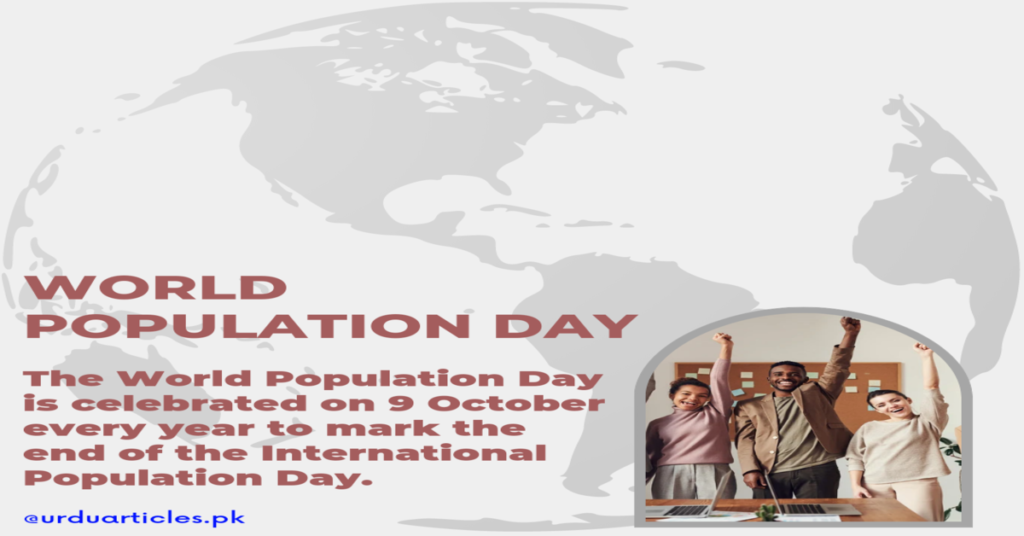World Population Day 2023
World population Day 2023
1. Introduction to World Population Day and What it is all About.
On Tuesday, October 11th, the United Nations Population Fund (UNFPA) will be celebrating World Population Day. This day is aimed at raising awareness about population issues and celebrating the progress that has been made in reducing population growth.
According to the UNFPA, World Population Day “aims to build political will, raise awareness, and catalyze action to achieve the global goals of population and development.” The global goals are a set of goals that the UNFPA has set out to achieve by 2030. These goals include reducing the number of people living in poverty, achieving universal education, and reducing the number of deaths from preventable causes.
World Population Day is a great opportunity to focus on the global population issues that we face. We need to be aware of the population growth that is happening around the world, and work to reduce it. We can do this by working to improve the education of women and girls, and by promoting effective family planning options.
2. The History of World Population Day and its Importance.
The World Population Day is celebrated on 9 October every year to mark the end of the International Population Day. The date was chosen to coincide with the United Nations International Day of Population and Development, which falls on 10 October.
The date was chosen in 1952 to commemorate the signing of the United Nations Convention on the Reduction of Child Mortality.
The Convention, which was adopted by the United Nations General Assembly on 17 November 1949, called for all countries to take measures to reduce child mortality. The world population reached 6.2 billion on 9 October 2011, according to the United Nations Population Fund. This makes the world population the seventh largest in history. The population is projected to reach 8.5 billion by 2052, and 10.9 billion by 2100.
The world population has grown exponentially since the beginning of the human race. The population grew from about 1.6 billion in 1800 to 6.2 billion in 2011. This means that the world population has grown by about 6.5 billion.
3. The current world population and its projected future.
The world population is projected to reach 9.7 billion by the year 2050. This is an increase from the current population of around 7.3 billion. The increase in population is due to a number of factors, including increased fertility rates in certain parts of the world, as well as increased longevity. The global population is projected to reach 11.2 billion by the year 2100.
The projected increase in population is a major concern, as it will put increasing demands on resources and create challenges in terms of ensuring access to food, housing, and health care. Additionally, the increased population will strain the environment, as the world will need to provide more resources to support the growing population.There are a number of ways to address the challenges posed by the increasing population.
One approach is to focus on reducing fertility. Which will have a significant impact on the number of people who are projected to be living in the world in the future.
Share of world population living in poverty 1990-2023
4. The effects of the world population on the environment and society.
Effects of Population Growth on the Environment
The world population is quickly reaching 7 billion people, and projections suggest that it could reach 10 billion by the year 2040. At this rate, the world’s population will exceed the capacity of the earth to support it. The earth’s resources, including land, water, and energy, will be strained to the limit.
The effects of population growth on the environment are complex and far-reaching. On the one hand, an increase in the world population can lead to an increase in the production of goods and services. On the other hand, an increase in the world population can lead to increased demands for resources, increased pollution, and increased conflict over land and resources.
The question of how best to manage the world’s population is a complex and difficult one. There is no single answer that will work for every country or every population. What is clear, however, is that the world’s population growth has serious.
5. Ways to reduce world population and implement population control measures.
Reduce World Population
One of the most important things we can all do to help reduce the world population is to use effective birth control. This is especially important as the world population continues to grow.
There are a number of different ways to use contraception to help reduce the population. Some methods are more effective than others, but all of them are highly effective in preventing pregnancies.
There are also other types of contraception, such as birth control pills, etc etc.
6. The current state of world population
There is no one definitive answer to this question, as the world population has continued to grow at a rapid rate for the past few decades. However, some key trends that have emerged in recent years include a growing number of people living in urban areas, a growing number of people who are obese or overweight, and a shrinking number of people who are active. Additionally, the number of people who are living in poverty has also been increasing in recent years.
7. The future of world population.
The future of world population is a question that has been on the minds of many people for years. Over the next few decades, the world is likely to see a significant increase in the number of people. This Increase is likely to be due to a number of factors, including the growth of economic and social opportunities, the spread of diseases, and the increase in global population size.
In order to meet the world’s growing population challenge, the world will need to make a number of key investments. These investments will include developing new technology and improved infrastructure, increasing access to education and healthcare, and increasing the use of renewable resources.
8. Lessons learned from world population day
On World Population Day, we all face the challenge of managing our population and ensuring that we provide a quality of life for all. Here are a few lessons learned from this years World Population Day.
a. It’s important to remember that population growth is not a new phenomena. The human population has been growing steadily for centuries, and while it has had some fluctuations, the overall trend is upwards.
b. It’s also important to take into account the impact of population growth on the environment. If we continue to grow at a rate that is unsustainable, we could end up damaging the planet in the future.
world population day facts
c. In addition, it’s important to make sure that we’re taking all necessary measures to prevent population growth from contributing to global poverty and inequality.
d. Finally, it’s important that we can all learn from the world population day successes and failures. The United Nations population day is an important event that happens every year to help keep track of the increasing issue of population growth. This year’s population day was good because we had the world’s best ever list of ingredients for a world health report.
The UN commission on population development (UNDP) released a report in 2006 that showed that the world’s population was now at 91 million. The UNDP team reported that the main issues surrounding the world population day are additive (ie. notable by the naked eye) and Asymmetric (ie. genetic). The main successes from the world population day this year are the increase of women in the workforce, the increasing age of leverage, and the decrease in crime. The world’s first population census took place in 1521 in the country of France.
Conclusion
World Population Day, a day to reflect on the state of the world’s population and the challenges we face in ensuring a sustainable future for all.
The world’s population is currently estimated at 7.6 billion. nd is projected to reach 9.8 billion by 2050. This rapid growth presents a number of challenges, including ensuring enough food and water for all, reducing greenhouse gas emissions to avert climate change, and providing healthcare and education for all.
We need to ensure that our planet can support the growing population and that all people have the opportunity to lead healthy, prosperous lives.
Summary World population Day 2023 :
World Population Day is a day to reflect on the state of the world’s population and the challenges posed by its rapid growth. We need to take action to ensure that our planet can support the growing population and that all people have access to food, water, healthcare, and education.
World population Day 2023
Check Today Islamic Hijri Date

Through my words, I Strive to evoke emotions, challenge Norms, and inspire change. Whether it’s delving into the complexities of human relationships, shedding light on social issues, or celebrating the beauty of our cultural heritage, I aim to create a lasting impact. With every word, I weave together stories that resonate with audiences, sparking conversations and fostering a sense of unity. Being a Pakistani content writer is not just a profession; it’s a responsibility to uplift and empower through the power of storytelling.

